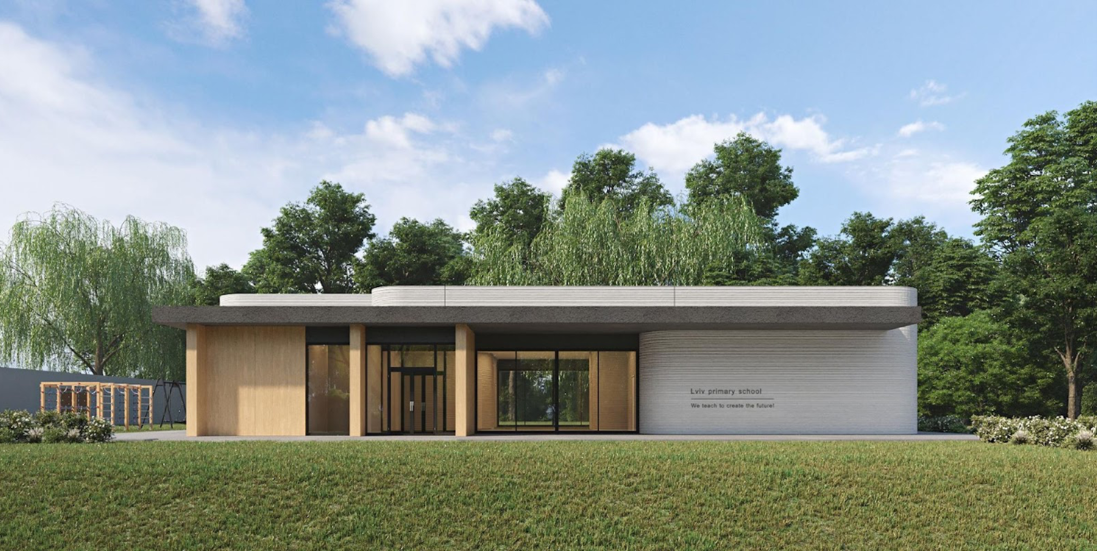A school in Lviv, Ukraine, has become Europe’s first 3D-printed educational institution, with the walls of its 370 square metre space made using a 3D concrete printer in just 40 hours. The pioneering project, carried out by the non-profit organisation Team4UA, is also the first 3D building in a war zone, demonstrating innovative construction techniques in difficult conditions, on Tuesday, the 26th of March, reports CNN.
The 3D concrete printer applies the concrete according to digital blueprints, just like a pastry chef puts the icing on a cake.
Due to the influx of internally displaced people fleeing the conflict in eastern Ukraine, Lviv was forced to host tens of thousands of people seeking refuge. According to the latest figures from the UN International Organisation for Migration, in December last year there were 173 000 internally displaced people in the Lviv region alone.
The Hive project will provide the school No 23 with four additional classrooms
to accommodate the extra pupils displaced by the war, said Jean-Christophe Bonis, founder of Team4UA. He hopes that, if successful, the project will allow “3D printing to become one of the tools of local construction in Ukraine”.
Team4UA worked with Ukrainian studio Balbek Bureau on the design of the school and with architectural firm Ars Longa on the architectural design.
The first works on the single-storey project started in September 2022 and the whole project, from the foundations to the finishing touches, was initially expected to take only three months. However, Russian air strikes and power grid disruptions halted progress, delaying work.
After the project’s opening date was pushed back to January 2024, another obstacle arose – financing.
Construction costs in Ukraine have skyrocketed over the past year, and project organisers say they need to raise another 400 000 US dollars to complete the final touches such as roofing, windows, doors and interior design.
However, the project organiser remains determined, believing that technology is a tool that will help to restore hope in times of hardship.
The Kyiv School of Economics estimates that it will cost 151.2 billion US dollars to rebuild Ukraine’s infrastructure. Between February 2022 and September 2023
more than 3 500 educational institutions and more than 160 000 houses were damaged or destroyed.
According to Bonis, in Lviv there is more excitement around the primary school building project than might have been expected.
“When I am on the construction site, children and their parents come up to me and say in Ukrainian: “I’m going to go to this school, I’m so happy, my school is the only one like this in the whole country”,” he said.
Andriy Zakaliuk, Head of the Education Department of the Lviv City Council, described the project as a “unique opportunity” in an e-mail to CNN, saying that it was symbolic that the pupils would start their new phase of life in a new, modern environment.
“Now these children have the opportunity to see that with the help of a 3D printer they can build real buildings,” Zakaliuk said.
Ahead of the new school building’s opening date, Bonis is planning two more ambitious 3D projects – a bridge in Kherson and an eight-storey building in Kyiv.
With these pilot projects, Team4UA aims to improve speed and efficiency while reducing the cost of future projects. Bonis is also planning to set up a private company to offer “printing as a service” in Ukraine, the profits of which will support Team4UA’s humanitarian work.
“It’s not just a concept of printing for schools – it’s a vision for this country,” said Bonis. “Sooner or later the war will end. At that point, we will have to go back to life, start building again and turn over a new page.”
Also read: VIDEO | Russia launches largest ever attack on Ukraine’s energy infrastructure
Follow us on Facebook and X!

